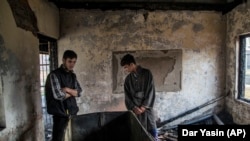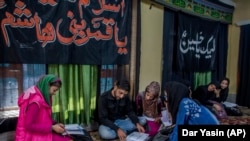Unidentified attackers have set fire to more than 20 schools in Indian Kashmir over the past two months.
Education is the latest victim of the conflict for control of the region.
India’s central government controls the state of Jammu and Kashmir.
For almost 20 years, groups have protested and even fought against government forces for the right to separate from India.
But this is the first time attackers have targeted so many schools. Islamist militants usually attack military or police targets in and around the Himalayan valley. Most schools have been closed for almost four months in Indian Kashmir.
The Jammu and Kashmir High Court called on the state government to protect schools after attackers burned three schools late last month. The court said the government should “unmask the enemies of education” and deal with them with an “iron hand.”
However, there seems to be no clear idea of who attacked the school buildings. The fires completely destroyed some of the schools. Others only burned a little.
Observers say the number of fires rose after the state government attempted to reopen schools and it said schools would hold examinations, as planned.
At first, the government closed schools because of a curfew it declared after security forces killed a militant leader in July. His death led to violent anti-India protests. About 90 people died in the unrest.
Soon after, some separatist leaders added orders to attack schools in their weekly directives to their followers.
Top state officials say the separatists want to raise a generation of uneducated young people. That way the separatists will have more followers to carry out attacks.
“That is the [plan],” Kashmir education minister Naeem Akhtar told VOA. “To keep them away from schools and have cannon fodder ready. … [The separatists] have [let business] work partially. The private trade, everything is going on. [This] is about denying education to students.”
The All Parties Huriyat Conference is the main coalition of separatist groups in Indian Kashmir. It argues that the attacks are part of a plan to create bad publicity for the group and “paint it as violence and anarchy.”
But observers say, through all the attempts to place blame, the real victims are the tens of thousands of students living in the Himalayan valley.
The government wants the schools to reopen to show that things in Indian Kashmir are back to normal. The area is facing its longest period of conflict since the end of a violent separatist movement 15 years ago.
Yet a top separatist leader, Syed Ali Shah Geelani, has said they will only let schools re-open once the government agrees to their demands. He and his followers want the government to release all those arrested during the protests.
Radha Kumar is a policy researcher. She once represented the government in Kashmir when the area was hit by protests six years ago.
“It is just so sad that all issues in Kashmir begin to become about propaganda or rhetoric when there are very important daily life issues,” she said. “It is between ridiculous and tragic.”
Both the police and state government have asked the local community for help in protecting the schools. They say it is impossible to protect more than 12,000 schools spread over the mountainous region.
While the recent attacks have made many people angry, Education Minister Akhtar sees hope. He feels the events have shown people how important education is. And he believes people will work together to protect it.
Many people in Indian Kashmir distrust security forces and the state government. But Radha Kumar says on the issue of education, public opinion is with the government.
“What the government does have in their favor is that there is now a large public outcry against the burning of the schools,” she said. “That should help them a great deal if they show a serious commitment to reopening schools and providing education.”
However, some still fear recent events are a sign of the return to the violence Kashmir experienced in the 1990s.
I’m Pete Musto.
Anjana Pasricha reported on this story for VOANews.com. Pete Musto adapted her report for Learning English. George Grow was the editor.
We want to hear from you. How can the government and separatist try to resolve these conflicts? How can students receive the education they need? Write to us in the Comments Section or on our Facebook page.
______________________________________________________________
Words in This Story
region – n. a part of a country or of the world that is different or separate from other parts in some way
unmask – v. to reveal the true identity or nature of someone or something
cannon fodder – n. soldiers who are sent into battle even though it is likely that they will die
rhetoric – n. language that is intended to influence people and that may not be honest or reasonable
ridiculous – adj. extremely silly or unreasonable







